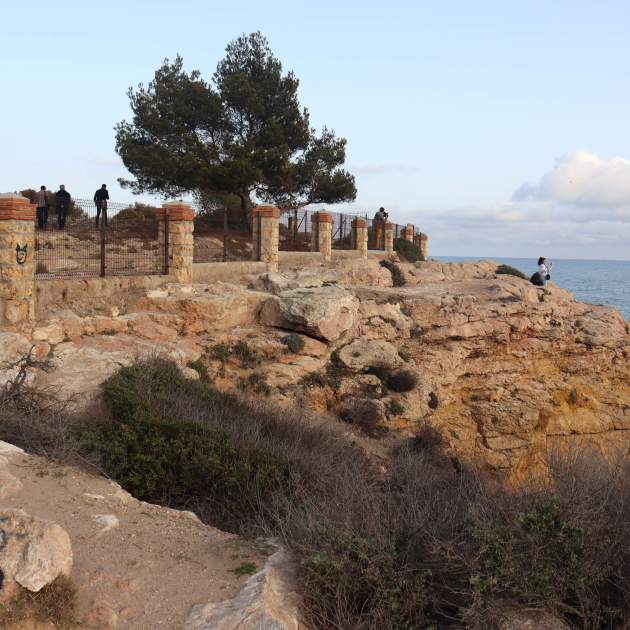The environmental group Ecologistas en Acción has presented its Black Flags 2024 report, which lists the most serious environmental problem areas on the coast of Catalonia, as well as including those on the rest of Spain. As for every year since 2005, two such flags are awarded per province: one for pollution and another for poor environmental management. Thus, with three coastal provinces in Catalonia, there are six black flags on the Catalan coast for the summer of 2024: what are they and where?
First of all, it should be noted that, this year, the environmental NGO has highlighted what they consider to be "one of the biggest social and environmental problems on the coast": the touristification and urbanization of the coast. With the six black flags awarded, Ecologistas en Acción intends to point out the consequences of this touristification in the abuse of coastal and natural spaces by holidaymakers on the Costa Brava.
Touristification and concentration of plastics
And as well, this year's report also puts the spotlight on another serious environmental problem: high concentrations of plastics, especially with reference to pellets. Readers may remember that at the beginning of this year there was a significant spillage of plastic pellets on Spain's Atlantic coastline, centred on Galicia, but this problem is by no means exclusive to the Atlantic coasts. In fact, Catalonia has the beach that is most polluted by pellets in the whole Spanish state. The ecoactivists affirm that the high level of plastic pollution experienced on the beaches of the Costa Daurada - "almost more plastic than sand" - are part of the major environmental problems resulting from the discharge of waste from the petrochemical industries based near Tarragona.
Thus, the Ecologistas comment that the black flags awarded to the demarcations of Barcelona and Tarragona underline "the artificialization of the coast, with the problems of erosion and loss that it entails". "Almost the entire coast of the Barcelonès county is asphalted up to the sand and attempts are made to preserve it with patches, instead of stopping urbanization; in Tarragona, in the historic area of La Savinosa, there are also plans to pave over a path, when the reality is that it isn't necessary," adds the environmental organization.
1. Platja de la Pineda
It is in Vila-seca (Tarragonès county) that the Platja de la Pineda, the beach that receives the highest proportion of pellets, is found, according to the Spanish ecological transition ministry. However, it should be stressed that the entire Costa Dorada suffers from this pollution. The environmental group says that the cause is the poor management of waste from the petrochemical industries and they demand that the administrations regulate this problem, which affects the entire Mediterranean.
2. Preventori de la Savinosa
Last year, the Preventori de la Savinosa - originally a 1930s coastal health centre for children - already received a black flag, but for a different reason. This year, the problem detected is the plan by the Tarragona provincial authority to expand the existing ronda, or coastal path, into a 5-metre-wide roadway as it passes through the Preventori, "without taking into account the destruction that this will involve to the habitats of natural interest". In fact, the ecologists say that there is no "need" either because there is a bike path 200 metres away, which takes the same route as the one whose construction is intended.
3. The Maresme coast
According to Ecologistas en Acción, the Maresme coast, stretching north-east from Barcelona, is excessively urbanized and artificial. This makes it more vulnerable to the effects of the climate crisis and the warming of the Mediterranean, which manifest in rising sea levels and tropical storms. Experts emphasize the need to de-urbanize and flexibilize the coastal areas that are most altered by humans, exposed to climate risks, and close to natural spaces, in order to recover the dynamics of coastal ecosystems as far as possible. However, the green group affirms that neither the Catalan government nor the General Directorate of Coasts offer useful measures and instead they continue to propose the construction of new marinas, buildings, dikes and breakwaters.
4. The three chimneys of Sant Adrià del Besòs
In the three chimneys of Sant Adrià del Besòs, at the north-east end of the Barcelona city coast, there is an urbanization project to build almost 2,000 flats, in addition to offices, shops and 20,000 square metres of hotel space. A platform of 44 associations, including Ecologistas en Acción, have presented an appeal to avoid this development, defend the re-naturation of the area and denounce the contradiction of such construction given the current climate emergency. It is one of the few corners of Barcelona's coastline that is currently undeveloped, in addition to being located in a flood-prone zone which is also one of the most densely populated urban areas in Europe.
5. The Costa Brava
This black flag does not refer to one specific point, but rather to the problems posed by private pleasure boats along the length of the Costa Brava: they erode the natural environment, damage marine biodiversity and create situations of risk due to the lack of control of their activities. In addition, according to Ecologistas en Acción, some of them invade areas reserved for bathers and go beyond the strip which coastal law says they must stay within. Finally, anchoring of boats negatively affects the posidonia marine meadows.
6. La Farella
The Llançà municipal council (Alt Empordà county) has given provisional approval to an urbanization plan to construct 62 homes on a plot of land in La Farella, the last pine grove on the coast near Llançà. That is to say, a stronghold of Mediterranean vegetation and fauna in an urban area dominated by cement and housing development, according to the ecological NGO.
